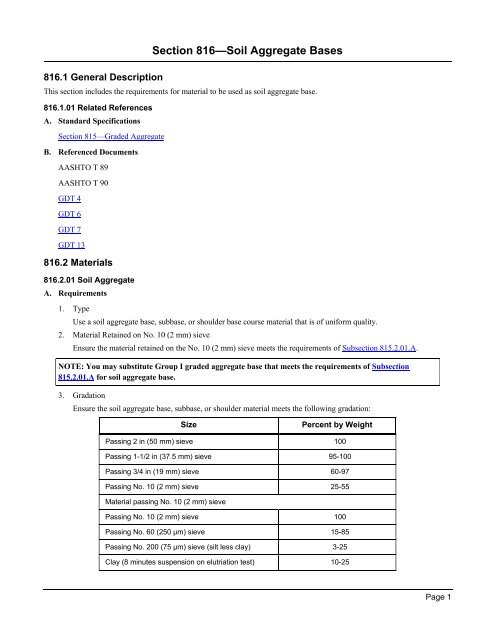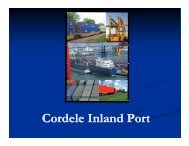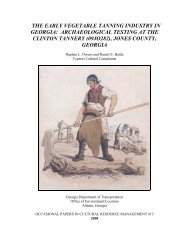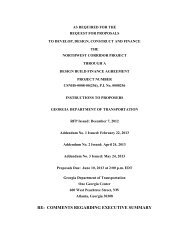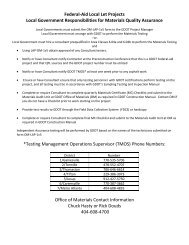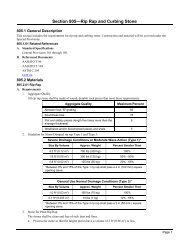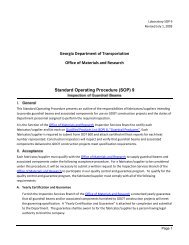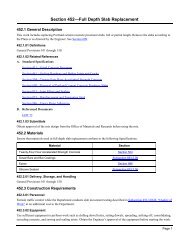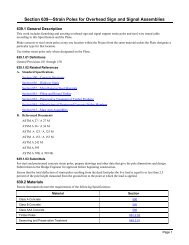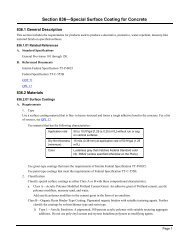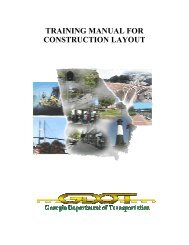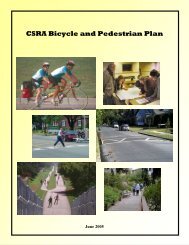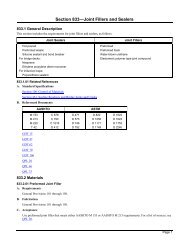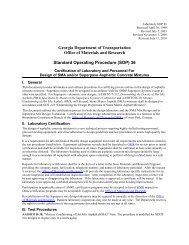Section 816 Soil Aggregate Bases
Section 816 Soil Aggregate Bases
Section 816 Soil Aggregate Bases
You also want an ePaper? Increase the reach of your titles
YUMPU automatically turns print PDFs into web optimized ePapers that Google loves.
<strong>816</strong>.1 General Description<br />
<strong>Section</strong> <strong>816</strong>—<strong>Soil</strong> <strong>Aggregate</strong> <strong>Bases</strong><br />
This section includes the requirements for material to be used as soil aggregate base.<br />
<strong>816</strong>.1.01 Related References<br />
A. Standard Specifications<br />
<strong>Section</strong> 815—Graded <strong>Aggregate</strong><br />
B. Referenced Documents<br />
AASHTO T 89<br />
AASHTO T 90<br />
GDT 4<br />
GDT 6<br />
GDT 7<br />
GDT 13<br />
<strong>816</strong>.2 Materials<br />
<strong>816</strong>.2.01 <strong>Soil</strong> <strong>Aggregate</strong><br />
A. Requirements<br />
1. Type<br />
Use a soil aggregate base, subbase, or shoulder base course material that is of uniform quality.<br />
2. Material Retained on No. 10 (2 mm) sieve<br />
Ensure the material retained on the No. 10 (2 mm) sieve meets the requirements of Subsection 815.2.01.A.<br />
NOTE: You may substitute Group I graded aggregate base that meets the requirements of Subsection<br />
815.2.01.A for soil aggregate base.<br />
3. Gradation<br />
Ensure the soil aggregate base, subbase, or shoulder material meets the following gradation:<br />
Size<br />
Percent by Weight<br />
Passing 2 in (50 mm) sieve 100<br />
Passing 1-1/2 in (37.5 mm) sieve 95-100<br />
Passing 3/4 in (19 mm) sieve 60-97<br />
Passing No. 10 (2 mm) sieve 25-55<br />
Material passing No. 10 (2 mm) sieve<br />
Passing No. 10 (2 mm) sieve 100<br />
Passing No. 60 (250 µm) sieve 15-85<br />
Passing No. 200 (75 µm) sieve (silt less clay) 3-25<br />
Clay (8 minutes suspension on elutriation test) 10-25<br />
Page 1
<strong>Section</strong> <strong>816</strong>—<strong>Soil</strong> <strong>Aggregate</strong> <strong>Bases</strong><br />
B. Fabrication<br />
Ensure that the material passing the No. 10 (2 mm) sieve has a total volume change of 15 or less.<br />
Ensure that the material passing the No. 40 (425 µm) sieve has a Liquid Limit (LL) of 25 or less and a Plasticity<br />
Index (PI) of 9 or less.<br />
General Provisions 101 through 150.<br />
C. Acceptance<br />
Test as follows:<br />
Test<br />
Method<br />
Gradation GDT 4 and GDT 13<br />
Volume change GDT 6<br />
Liquid limit AASHTO T 89<br />
Plastic limit and plasticity index AASHTO T 90<br />
D. Materials Warranty<br />
General Provisions 101 through 150.<br />
<strong>816</strong>.2.02 <strong>Soil</strong> Mortar for <strong>Soil</strong> <strong>Aggregate</strong> Base<br />
A. Requirements<br />
Use a soil mortar for soil aggregate bases of friable materials meeting these requirements:<br />
Percent passing No. 200 (75 µm) sieve 0-65<br />
Volume change 0-15<br />
Maximum dry density 95 lb/ft³+ (1520 kg/m³ +)<br />
B. Fabrication<br />
General Provisions 101 through 150.<br />
C. Acceptance<br />
Test as follows:<br />
Test<br />
Method<br />
Gradation GDT 4<br />
Volume change GDT 6<br />
Maximum dry density GDT 7<br />
D. Materials Warranty<br />
General Provisions 101 through 150.<br />
Page 2


